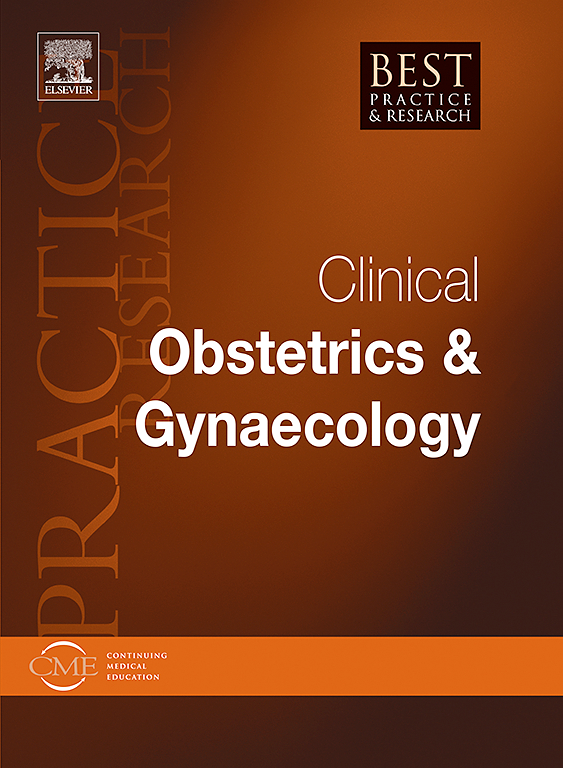大胎盘绒毛膜血管瘤的诊断和治疗
IF 4.1
2区 医学
Q1 OBSTETRICS & GYNECOLOGY
Best Practice & Research Clinical Obstetrics & Gynaecology
Pub Date : 2025-07-23
DOI:10.1016/j.bpobgyn.2025.102644
引用次数: 0
摘要
大的绒毛膜血管瘤,最大直径≥4cm的胎盘良性血管肿瘤,可能对持续妊娠构成重大风险,需要进行彻底的超声检查,以评估胎儿心脏损害和胎儿贫血的证据。巨大的绒毛膜血管瘤与围产期发病率和死亡率密切相关。在大绒毛膜血管瘤的情况下,胎儿受损的关键超声标记包括:1)羊水过多,2)大脑中动脉(MCA) PSV升高(中位[MoM]的倍数≥1.5),3)合并心输出量(CCO)和/或三尖瓣反流(TR)增加,伴有或无胎儿心脏肥大的证据,4)胎儿积水。当怀疑有大胎盘绒毛膜血管瘤时,应考虑转诊到具有复杂胎儿护理管理专业知识的胎儿中心,以评估子宫内干预的候选性。如果需要宫内胎儿介入治疗,胎盘的位置、绒毛膜血管瘤“喂食血管”的数量和口径以及绒毛膜血管瘤与胎盘脐带插入点的接近程度可以指导手术入路的决定。尽管宫内胎儿干预,围产期发病率和死亡率仍然很高,30 - 40%导致围产期死亡,约50%导致早产。本文章由计算机程序翻译,如有差异,请以英文原文为准。
Diagnosis and management of large placental chorioangiomas
Large chorioangiomas, benign vascular tumors of the placenta measuring ≥ 4 cm in greatest diameter, may pose significant risks to an ongoing pregnancy and warrant thorough sonographic evaluation to assess for evidence of fetal cardiac compromise and fetal anemia. Significant perinatal morbidity and mortality has been associated with large chorioangiomas. Key sonographic markers indicative of fetal compromise in the setting of a large chorioangioma include 1) polyhydramnios, 2) elevated middle cerebral artery (MCA) PSV (multiples of the median [MoM] ≥ 1.5), 3) increased combined cardiac output (CCO) and/or tricuspid regurgitation (TR) with or without evidence of fetal cardiomegaly, and 4) fetal hydrops. When fetal compromise is suspected in the setting of a large placental chorioangioma, referral to a fetal center with high-volume expertise in management of complex fetal care should be considered to evaluate for in-utero intervention candidacy. If in-utero fetal intervention is indicated, the placental location, the number and caliber of “feeder vessels” to the chorioangioma, and the proximity of the chorioangioma to the placental cord insertion guide the decision of surgical approach. Despite in-utero fetal intervention, perinatal morbidity and mortality remains high with 30–40 % resulting in perinatal death and about 50 % resulting in preterm birth.
求助全文
通过发布文献求助,成功后即可免费获取论文全文。
去求助
来源期刊
CiteScore
9.40
自引率
1.80%
发文量
113
审稿时长
54 days
期刊介绍:
In practical paperback format, each 200 page topic-based issue of Best Practice & Research Clinical Obstetrics & Gynaecology will provide a comprehensive review of current clinical practice and thinking within the specialties of obstetrics and gynaecology.
All chapters take the form of practical, evidence-based reviews that seek to address key clinical issues of diagnosis, treatment and patient management.
Each issue follows a problem-orientated approach that focuses on the key questions to be addressed, clearly defining what is known and not known. Management will be described in practical terms so that it can be applied to the individual patient.

 求助内容:
求助内容: 应助结果提醒方式:
应助结果提醒方式:


